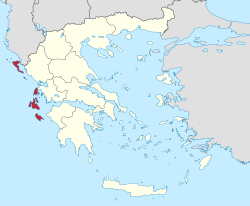Ionian Islands (region)
| Ionian Islands Περιφέρεια Ιονίων Νήσων | |
|---|---|
| Administrative region of Greece | |
 | |
| Coordinates: GR 38°42′N 20°18′E / 38.7°N 20.3°ECoordinates: GR 38°42′N 20°18′E / 38.7°N 20.3°E | |
| Country |
|
| Decentralized Administration | Peloponnese, Western Greece and the Ionian |
| Capital | Corfu |
| Regional units | |
| Government | |
| • Regional governor | Theodoros Galiatsatos (SYRIZA) |
| Area | |
| • Total | 2,306.94 km2 (890.71 sq mi) |
| Population (2011)[1] | |
| • Total | 207,855 |
| • Density | 90/km2 (230/sq mi) |
| Time zone | EET (UTC+2) |
| • Summer (DST) | EEST (UTC+3) |
| ISO 3166 code | GR-F |
| Website |
www |
The Ionian Islands Region (Greek: Περιφέρεια Ιονίων Νήσων) is one of the thirteen administrative regions of Greece. The administrative region does not include all of the Ionian Islands; the island of Kythera, which historically was part of the island group, now belongs to Attica.
Demographics
The population of the Ionian Islands in 2011 was 207,855, decreased by 1,50% compared to the population in 2001. Nevertheless, the region remains the third by population density with 90.1/km² nationwide, well above the national of 81.96/km². The most populous of the major islands is Corfu with a population of 104,371, followed by Zante (40,759), Cephalonia (35,801), Leucas (23.693) and Ithaca (3.231). The foreign-born population was in 2001 19,360 or 9.3%, the majority of which was concentrated in Corfu and Zante. Most of them originate from Albania (13,536). The fertility rate for 2011 according to Eurostat was 1.35 live births per woman.[2]
Economy
The regional Gross Domestic Product for 2010 was 4,029 million euros. The GDP per capita for the same year was 18,440 euros per capita which was lower than the national median of 20,481. However, the GDP per capita of Cephalonia and Zante, 23,275 and 24,616 respectively, was much higher than the national figure.[3] Additionally, unemployment for 2012 was 14.7, the lowest among all Greek regions, and much lower compared to the national unemployment of 24.2.[4]
Tourism
The region is a popular tourist destination. The airports of Corfu, Zante and Cephalonia were in the top ten in Greece by number of international arrivals, with 1,386,289 international arrivals for 2012, with Corfu being the sixth airport by number of arrivals nationwide, while Zante and Cephalonia also being in the top ten. Cephalonia Airport had the biggest increase nationwide by 13.11% compared to 2011, while Corfu had an increase of 6.31%.[5][6]
Administration
The region was established in the 1987 administrative reform, comprising the prefectures of Corfu, Kefalonia and Ithaca, Lefkada and Zakynthos.
With the 2010 Kallikratis plan, its powers and authority were redefined and extended. Along with West Greece and Peloponnese regions, it is supervised by the Decentralized Administration of the Peloponnese, West Greece and the Ionian Islands based at Patras. The region is based at Corfu and is divided into 5 regional units:[7]

The region's governor is, since 1 September 2014, Theodoros Galiatsatos, who was elected in the May 2014 local administration elections for the Coalition of the Radical Left party.
Historical population
| Year | Population | Density |
|---|---|---|
| 1862 | 228,631 | 87.8/km² |
| 1864 | 229,516 | |
| 1879 | 244,433 | 106.0/km² |
| 1889 | 238,783 | |
| 1896 | 282,853 | |
| 1907 | 254,494 | |
| 1920 | 224,189 | 97.1/km² |
| 1928 | 213,157 | 92.4/km² |
| 1940 | 219,562 | 95.1/km² |
| 1951 | 228,597 | 99.0/km² |
| 1961 | 207,061 | 89.7/km² |
| 1971 | 184,443 | |
| 1981 | 182,651 | 79.1/km² |
| 1991 | 193,734 | 83.9/km² |
| 2001 | 212,984 | 92.3/km² |
| 2011 | 207,855 | 90/km² |
References
- ↑ "Demographic and social characteristics of the Resident Population of Greece according to the 2011 Population - Housing Census revision of 20/3/2014" (PDF). Hellenic Statistical Authority. 12 September 2014.
- ↑ "Eurostat - Tables, Graphs and Maps Interface (TGM) table". Epp.eurostat.ec.europa.eu. Retrieved 2014-04-11.
- ↑ "PAGE-themes". Statistics.gr. Retrieved 2014-04-11.
- ↑ "EUROPA - PRESS RELEASES - Press release - Unemployment in the EU27 regions in 2012 Regional unemployment rates ranged from 2.5% in Salzburg and Tirol to 38.5% in Ceuta and 34.6% in Andalucía". Europa.eu. Retrieved 2014-04-11.
- ↑ "SETE : Greek Tourism : Facts and Figures" (PDF). Sete.gr. Retrieved 2015-03-01.
- ↑ "International Tourist Arrivals at the Main Airports : January-December 2011-12" (PDF). Tovima.gr. Retrieved 2015-03-01.
- ↑ "Kallikratis reform law text" (PDF). Kedke.gr. Retrieved 2015-03-01.
- ↑ "Statistics". Xantho.lis.upatras.gr. Retrieved 2015-03-01.
- ↑ "Document" (PDF). Dlib.statistics.gr. Retrieved 2015-03-01.
- ↑ Archived May 30, 2013, at the Wayback Machine.
- ↑ "Εργαστήριο Δημογραφικών και Κοινωνικών Αναλύσεων Πανεπιστημίου Θεσσαλίας - Εργο e-Demography - Δεδομένα απογραφής 1971 - Πραγματικός πληθυσμός - Συνολικά". E-demography.gr. Retrieved 2014-04-11.
- ↑ "Statistical Yearbook of Greece" (PDF). Dlib.statistics.gr. Retrieved 2015-03-01.
- ↑ Archived March 25, 2012, at the Wayback Machine.
External links
| Wikimedia Commons has media related to Ionian Islands. |
- Official website (Greek)